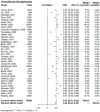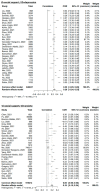The Association of Social Support and Loneliness with Symptoms of Depression, Anxiety, and Posttraumatic Stress during the COVID-19 Pandemic: A Meta-Analysis
- PMID: 36833463
- PMCID: PMC9957328
- DOI: 10.3390/ijerph20042765
The Association of Social Support and Loneliness with Symptoms of Depression, Anxiety, and Posttraumatic Stress during the COVID-19 Pandemic: A Meta-Analysis
Abstract
Background: Research suggests that changes in social support and loneliness have affected mental disorder symptoms during the COVID-19 pandemic. However, there are a lack of studies comparing the robustness of these associations.
Aims: The aims were to estimate the strength of the associations of loneliness and social support with symptoms of depression, anxiety, and posttraumatic stress during the COVID-19 pandemic (2020-2022) in the general population.
Method: The method entailed a systematic review and random-effects meta-analysis of quantitative studies.
Results: Seventy-three studies were included in the meta-analysis. The pooled correlations of the effect size of the association of loneliness with symptoms of depression, anxiety, and posttraumatic stress were 0.49, 0.40, and 0.38, respectively. The corresponding figures for social support were 0.29, 0.19, and 0.18, respectively. Subgroup analyses revealed that the strength of some associations could be influenced by the sociodemographic characteristics of the study samples, such as age, gender, region, and COVID-19 stringency index, and by methodological moderators, such as sample size, collection date, methodological quality, and the measurement scales.
Conclusions: Social support had a weak association with mental disorder symptoms during the COVID-19 pandemic while the association with loneliness was moderate. Strategies to address loneliness could be highly effective in reducing the impact of the pandemic on social relationships and mental health.
Keywords: COVID-19; anxiety symptoms; depressive symptoms; loneliness; posttraumatic stress symptoms; social support.
Conflict of interest statement
The authors declare that they have no potential conflict of interest with respect to the research, authorship, and/or publication of this article.
Figures





References
-
- Salari N., Hosseinian-Far A., Jalali R., Vaisi-Raygani A., Rasoulpoor S., Mohammadi M., Rasoulpoor S., Khaledi-Paveh B. Prevalence of Stress, Anxiety, Depression among the General Population during the COVID-19 Pandemic: A Systematic Review and Meta-Analysis. Global. Health. 2020;16:57. doi: 10.1186/s12992-020-00589-w. - DOI - PMC - PubMed
-
- O’Sullivan R., Burns A., Leavey G., Leroi I., Burholt V., Lubben J., Holt-Lunstad J., Victor C., Lawlor B., Vilar-Compte M., et al. Impact of the COVID-19 Pandemic on Loneliness and Social Isolation: A Multi-Country Study. Int. J. Environ. Res. Public Health. 2021;18:9982. doi: 10.3390/ijerph18199982. - DOI - PMC - PubMed
-
- Palgi Y., Shrira A., Ring L., Bodner E., Avidor S., Bergman Y., Cohen-Fridel S., Keisari S., Hoffman Y. The Loneliness Pandemic: Loneliness and Other Concomitants of Depression, Anxiety and Their Comorbidity during the COVID-19 Outbreak. J. Affect. Disord. 2020;275:109–111. doi: 10.1016/j.jad.2020.06.036. - DOI - PMC - PubMed
-
- Liu C.H., Zhang E., Wong G.T.F., Hyun S., Hahm H. “Chris” Factors Associated with Depression, Anxiety, and PTSD Symptomatology during the COVID-19 Pandemic: Clinical Implications for U.S. Young Adult Mental Health. Psychiatry Res. 2020;290:113172. doi: 10.1016/j.psychres.2020.113172. - DOI - PMC - PubMed
-
- World Health Organization . Mental Health and COVID-19: Early Evidence of the Pandemic’s Impact: Scientific Brief. World Health Organization; Geneva, Switzerland: 2022.
Publication types
MeSH terms
LinkOut - more resources
Full Text Sources
Medical

